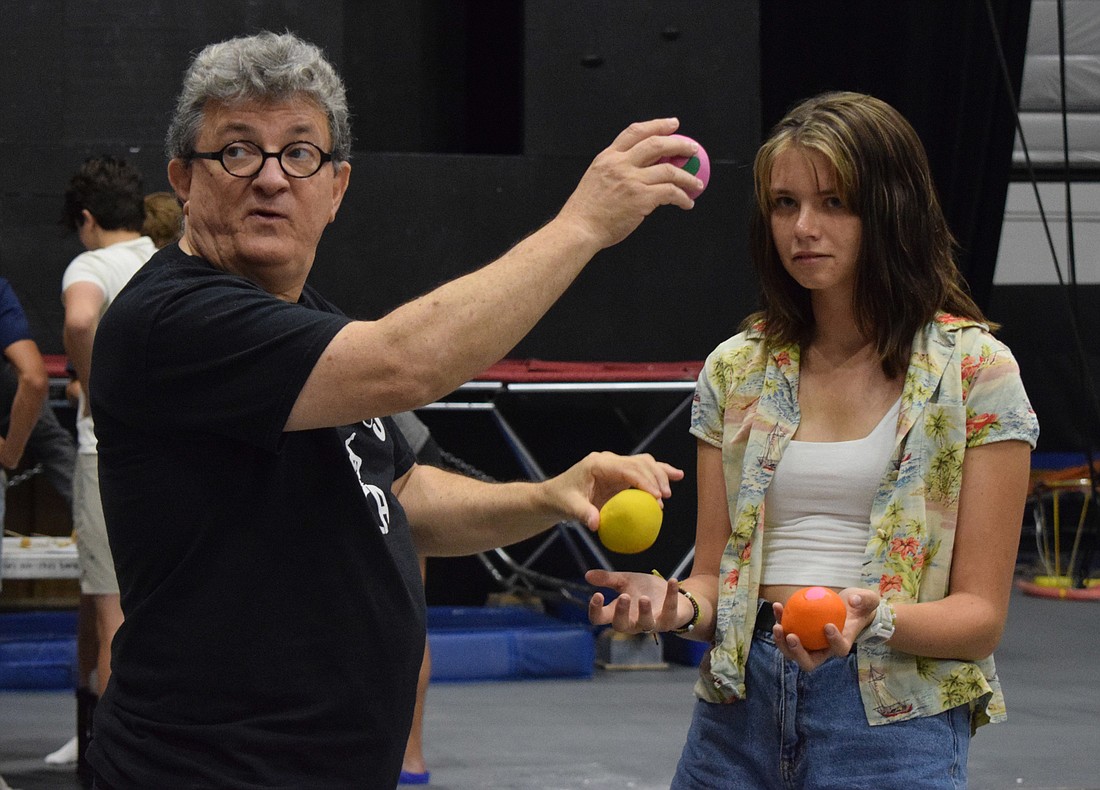- April 23, 2024
-
-
Loading

Loading

Maggie Fincher, a junior at The Out-of-Door Academy, jumped onto the thin lyra hoop hanging from the ceiling.
Rikki Heddig-Rolfe Meaux, a Circus Arts Conservatory coach, instructed Fincher to hold onto the lyra hoop with her dominant hand while extending her legs and other arm out in an attempt to put her body into a straight line.
Fincher then crunched her body into a ball while holding onto the hoop, causing it to spin.
And besides learning some cool circus tricks, she was able to learn about kinetic and potential energy as well as gravity.
A group of junior physics students from ODA went to the Circus Arts Conservatory on April 5 to learn how physics applies to the circus arts.
"You get a different level of engagement when you're out in the world experiencing things," said Caitlyn Dixon, the science, technology, engineering and mathematics director at ODA. "We do a great job of incorporating labs and activities in classrooms, but students engage differently depending on what your environment is."
Through juggling, jumping on a trampoline, walking across a tight wire and doing stunts on a Lyra Hoop, students were able to see how factors such as mass, friction, gravity, kinetic energy, unbalanced forces, velocity and more impact the circus arts.
"It was cool to be able to see what goes into all these tricks," junior Reece Phillips said. "It's definitely difficult, and it's amazing to see how hard people work to make it all possible."
Seeing how physics could be applied in the real world piqued some students' interest in learning more about the subject, as well as the circus arts.
"You don't realize how much of it you use in real life," Fincher said.
The aerial stunts on the Lyra Hoop was a favorite among students.
"It made me feel like a monkey," Phillips said.
Students were able to try their hand at aerial stunts using a lyra hoop.
Kinetic energy: Students jumped onto the hoop and extended their bodies to try to make a straight line before crunching up into a ball, causing the lyra hoop to speed faster.
Potential energy: Rikki Heddig-Rolfe Meaux, a Circus Arts Conservatory coach, raised the hoop higher into the air and had students try different exercises, such as hanging from the hoop and moving their legs around or hanging upside down.
Students attempted to walk across a tight wire without falling.
Friction: Walking across the tight wire, students were able to see how their feet sliding across the wire caused friction.
Center of mass: Students held their arms out at their sides and tried to walk the tight wire with their center of mass directly over the rope.
Students had fun jumping and trying to do seat drops and flips on a trampoline.
Speed: Their energy influenced how fast they jumped
Velocity: The speed and direction in which the students moved while jumping on the trampoline demonstrated their velocity.
Acceleration: When students changed the speed or direction they were jumping at, they were demonstrating acceleration.
For many students, visiting the Circus Arts Conservatory was their first opportunity to try juggling. They started with throwing one ball in the air before adding a second and finally a third.
Balanced forces: When the ball lands in the student's hand and stops moving, the forces are balanced. All the forces pushing on the ball are the same.
Unbalanced forces: When a student throws the ball in the air, the forces are unbalanced. There is more force being applied to one side of the ball than the other side.